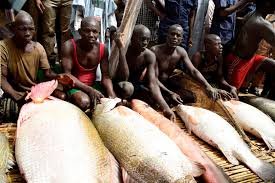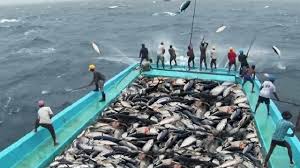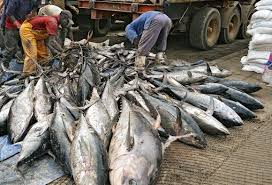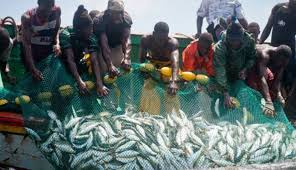The world’s fishing grounds have leveled off in the last decade, with the majority of wild stocks being fully exploited due to the increase in the demand for fish. Aquaculture production offers great potential in responding to the increased fish demand and has significantly increased world fish production by 20 million tonnes (mt) over the past decade. By the year 2010, the world fish food was set to increase to about 105 mt, and this increase from the current levels was again expected to come from aquaculture.
How this huge increase in fish supply would be achieved through aquaculture is detailed in this article.
Fishery Activities in Nigeria

Nigeria occupies a position between latitudes 4°16’–13°52’N and longitudes 2°49’–14°37’E, with a coastline of approximately 850 km bordering the Gulf of Guinea in the Atlantic Ocean. Consequently, Nigeria is a maritime state with the establishment of the Exclusive Economic Zone (EEZ) of 200 nautical miles in 1978. The major geomorphologic features of the Nigerian continental shelf include the Avon, Mahin, and Calabar Canyons.
Other features include sand banks in the inner continental shelf, especially off river mouths, and the deep-seated Romanche, Chain, and Charcot fracture zones originating from the Mid-Atlantic Ridge.
There are numerous inland water bodies in Nigeria estimated at about 12 million hectares, which are fairly rich in freshwater fish species. The marine waters, however, are not as rich in finfish resources but are known to be rich in shrimp and tuna resources.
There are two main sub-sectors that contribute to Nigeria’s fish production: capture fisheries and aquaculture.
Read Also: 7 Medicinal Health Benefits of Daffodils (Narcissus Plant)
Capture Fisheries

Artisanal fisheries in Nigeria constitute the most significant fishery sector in terms of the number of people engaged in or dependent upon it. This sector contributes a high percentage (66%) to the country’s fish production.
Yet, it remains the poorest in terms of standard of living, with fishermen generally earning a subsistence living. Small-scale fisheries can be categorized into coastal mechanized and canoe fisheries, brackish water/lagoon subsistence fisheries, and capture fisheries in man-made and natural lakes, rivers, and floodplains.
Both artisanal and industrial fishing activities are of great importance in Nigeria’s coastal and marine waters. The artisanal sector consists of small sub-sectors, such as lagoon, estuarine, and inshore canoe fisheries, characterized by low capital outlay, though this remains the backbone of fish production in Nigeria.
The industrial sector, on the other hand, is characterized by high capital outlay on vessels, cold storage, advanced technology, and foreign exchange generation.
Brackish water canoe fisheries operate with small traditional dug-out canoes of about 6m LOA, using gears such as set nets, cast nets, bonga drift nets, lift and scoop nets, and hooks. Coastal canoe fisheries operate up to and sometimes beyond seven nautical miles from inshore waters.
Though the Nigerian Sea Fisheries Decree (now Act) of 1971 reserves a 2-mile non-trawling zone exclusively for artisanal fishermen, they normally venture farther when operating motorized crafts. The distance from the coast depends on the range and size of the motorized or non-motorized canoe and the fish stocks being targeted.
Aquaculture
Fish farming, including freshwater and mariculture, is making a significant contribution to the global food fish supply. Aquaculture can range from simple ponds that rely on naturally occurring food sources to highly intensive systems with controlled water flow, aeration, and supplemental feeding.
It can be practiced in many forms, including inland fish farming, brackish water systems along the coast, and marine cages and net pens. Farm sizes can vary from thousands of hectares to small backyard operations. The majority of global aquaculture production (58% in 1999) comes from freshwater systems, followed by mariculture (36%) and brackish water systems (6%).
Aquaculture now represents more than 30% of total food fish production, compared to just 7% in 1973. Presently, global food fish production is around 72 million metric tonnes. In Nigeria, aquaculture production stands at 15,000 tonnes, ranking second in Africa after Egypt.
Together, Nigeria and Egypt account for 84% of Africa’s total fish production, with the rest of the continent contributing the remaining 16%, growing at an annual rate of 3% from 1985 to 1997. Based on a per capita fish consumption of about 13.0 kg per year, approximately 91 million metric tonnes would be required to meet fish demand by 2010.
In the coming decades, aquaculture will likely be the primary source of increased fish production to meet the challenge of food fish demand in Nigeria and worldwide. Public and private investments will be crucial in areas such as fish disease control, water pollution management, fish seed propagation, and the development of fish feed and nutrition.
Read Also: Bacterial Canker (Stone fruit trees): Description, Damages Caused, Control and Preventive Measures
Fishery Resources of Nigeria

Nigeria boasts diverse fish resources, including pelagic and demersal fin and shellfish species. The country is home to about 199 culturable fish species belonging to 35 families, while 9 shellfish families have also been identified. These resources are found on the continental shelf, which covers an area of 251,100 km² in the Gulf of Guinea. This area is further divided into three depth zones (0–10 m, 10–50 m, and 50–200 m).
Shrimp Resources
Shrimp resources are abundant around river mouths and lagoon entrances. The most important shrimp species include the pink shrimp (Penaeus notalis) and the tiger shrimp (Penaeus kerathurus). Parapeneopsis atlantica is also found in coastal shallow waters at depths of 0–20 m and holds significant local economic value. The royal shrimp (Parapenaeus longirostris) is found in deeper waters at depths of 60–400 m, with the highest abundance between 60 and 120 m in Nigerian waters.
Pelagic Fish Resources
The major pelagic species in Nigerian waters include the bonga fish (Ethmalosa fimbricata), Sardinella aurita, and Sardinella maderensis, among others. The bonga fish is the most valuable and abundant species in the artisanal fisheries sector, while the sardinellas, though less abundant, are also of economic importance.
The bonga fish is found along the entire tropical West African coastline, with high concentrations from Sierra Leone to Senegal and from Nigeria to Cameroon. Sardinella aurita, considered the most valuable clupeid in the Gulf of Guinea, supports large-scale canoe fishing in Ghana, Sierra Leone, and Côte d’Ivoire.
Offshore Pelagic Resources
Offshore pelagic species include commercially important fish such as tuna and other related species. The most prevalent species are the skipjack tuna (Katsuwonus pelamis), yellowfin tuna (Thunnus albacares), bigeye tuna (Thunnus obesus), and frigate tuna (Euthynnus alletteratus).
Skipjack and yellowfin tuna are the most abundant, making up 75% and 18%, respectively, of pole-and-line catches. Other West African countries rich in tuna resources include Senegal, Sierra Leone, Ghana, and São Tomé and Príncipe.
Fauna Resources of the Equatorial Zone
The fauna in Nigeria’s equatorial zone is characterized by a diversity of fish species. Longhurst (1961) classified the demersal fish resources into three main faunistic groups:
1. Croaker Fauna: This group includes silver to grey fish such as croakers (Pseudolithus spp.), threadfins (Galeoides decadactylus), and spadefish (Drepane africana). These species typically inhabit areas above the thermocline on mud and muddy sand deposits.
2. Snapper Fauna: This group is composed of red fish, including breams (Pagrus spp.), snappers (Lutjanus spp.), and gurnards (Trigla spp.). They are found on clean sand with shell fragments, and some species are eurybathic, meaning they occur both above and below the thermocline at depths of over 100 m.
3. Semi-Abyssal Fauna: Found between depths of 100 m and 400 m, this group includes small, red to black fish species such as Antigonia spp. and Capros spp., as well as deep-sea crabs like Geryon maritae.
Do you have any questions, suggestions, or contributions? If so, please feel free to use the comment box below to share your thoughts. We also encourage you to kindly share this information with others who might benefit from it. Since we can’t reach everyone at once, we truly appreciate your help in spreading the word. Thank you so much for your support and for sharing!
Read Also: Relationship Marketing Process and Approaches to the Study of Marketing

